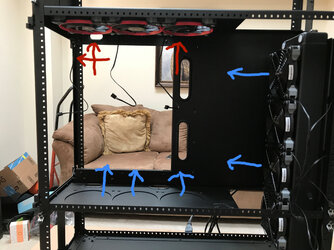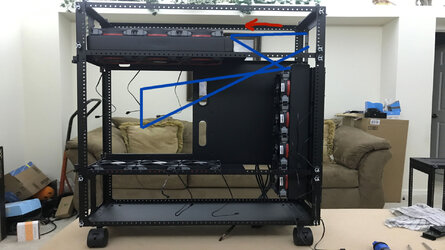- Joined
- Jan 5, 2005
- Location
- Ormond Beach, FL.
It's been quite awhile since I have been here. I've ripped my rig apart for an upgrade. I'm upgrading the hardware and downgrading the water-cooling. I think I'll stick with one rad and one pump to cool everything instead of the old setup that had four pumps, three res, 3 x 480 and 1 x 240 rads. Since I don't need all the space, I've removed the pedestal from my CaseLabs STH-10. I'll only be cooling the CPU and 2 x 1080 FTW, so one EK RX 480 should handle it.
Here's where I need your opinions. No recommending any other parts. This is what I have. One is for cooling and one is for a CPU. I didn't want to create two posts.
First, the CPU. I have an I7 6850K and sort of have an I7 6950X. The 6950X was bad and I had to RMA it. Intel did quite a turn around on the standard RMA. I wasn't about to give them 1700.00 for a cross-ship. I shipped it out on Tuesday. They received it yesterday and shipped the new one today. The old one kept rebooting at post and when it did boot, half my RAM wasn't being recognized. I stuck the 6950K in the Rampage V 10 and everything was fine. Should I keep the 6850 or 6950 and sell the other? I'm leaning toward keeping the 6850 for the higher clock speed and four less cores. Opinions?
Next question is about my case cooling. Should I add fans (Corsair AX120) to the bottom or leave it as is now?
Last question.... PSU at the top of the case or at the bottom? (AX1500i)
I appreciate the assistance!
Here's where I need your opinions. No recommending any other parts. This is what I have. One is for cooling and one is for a CPU. I didn't want to create two posts.
First, the CPU. I have an I7 6850K and sort of have an I7 6950X. The 6950X was bad and I had to RMA it. Intel did quite a turn around on the standard RMA. I wasn't about to give them 1700.00 for a cross-ship. I shipped it out on Tuesday. They received it yesterday and shipped the new one today. The old one kept rebooting at post and when it did boot, half my RAM wasn't being recognized. I stuck the 6950K in the Rampage V 10 and everything was fine. Should I keep the 6850 or 6950 and sell the other? I'm leaning toward keeping the 6850 for the higher clock speed and four less cores. Opinions?
Next question is about my case cooling. Should I add fans (Corsair AX120) to the bottom or leave it as is now?
Last question.... PSU at the top of the case or at the bottom? (AX1500i)
I appreciate the assistance!

